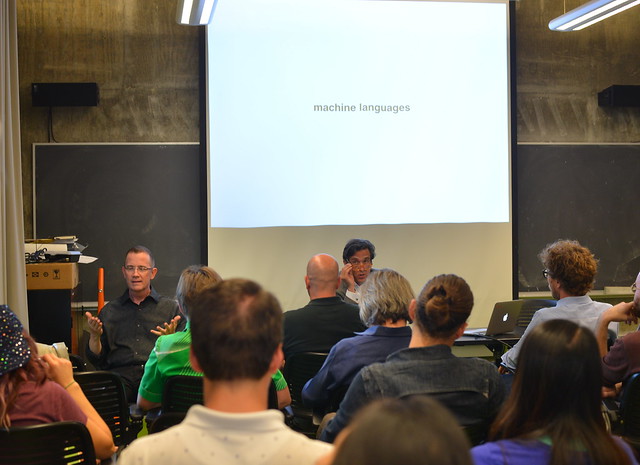HTNM 5th Anniversary and Revisited: "Technologies of Simulation"
The night of Wednesday the 14th marked a double celebration: the first event of the History and Theory of New Media 2015-16 lecture series and the fifth anniversary of the series, which is organized by professors Abigail De Kosnik (Theater, Dance and Performance Studies, BCNM) and David Bates (Rhetoric, BCNM). It was fitting that the speaker for this occasion, Dr. Claus Pias, is a preeminent scholar of New Media at Leuphana University in Germany, who exemplifies the type of multidisciplinary research that makes BCNM such a critical nexus for students and scholars from across the Berkeley, and the indeed broader academic community.
Currently a professor at Leuphana University in Germany, Dr. Pias studied Electrical Engineering at RWTH Aachen and Art History, German Literature, and Philosophy at the Rheinische Friedrich-Wilhelms-Universität Bonn. He received a PhD from Bauhaus-Universität in 2000 for his study of the pre-history of the computer game, published in 2002 as Computer Spiel Welten. This book is forthcoming in English as Computer Game Worlds, published by Amsterdam University Press as part of their book series, Recursions: Theories of Media, Materiality and Cultural Techniques.
Dr. Pias’ lecture examined a fascinating genealogy of machine translation (MT), noting intersections of philosophy, linguistics and computer science, and tracing lines of connection between multiple disciplines and research regimes that grew up around machine translation in Europe and the United States between the 1940s and 1970s. The lecture began with an analysis of how computer simulation opens new fields of scientifically treatable research, and changes the way we understand certain topics and questions in the sciences. Dr. Pias then shifted to the political and social premises of MT and traced its roots to computerized crypto-analysis, linguistics, and philosophical constructivism. Key figures in the development of MT include Leon Dostert, Victor Yngve, Silvio Ceccato, and Ernst von Glasersfeld, while key events include the MIT conference in 1952 and the 1954 demonstration at the IBM headquarters. For each of these events, Dr. Pias noted the institutional constructions and funding sources that were involved: for example, when Dostert co-founded the Institute of Languages and Linguistics at Georgetown University in 1949, this institute was part of the School of Foreign Service, and it was designed as a school for people training for the Foreign Service of the United States.
Dr. Pias’ lecture demonstrated how an excavation of MT histories reveals close affinities between philosophy and engineering, and how the formation of a constructivist epistemology has managed to “camouflage its technical-historical origins.” His analysis of relationships between language, thought, and representation revealed the complicated and intersecting histories of technology, politics, and philosophy, speaking to the generative possibilities of interdisciplinary research.
Check out the photos below!

